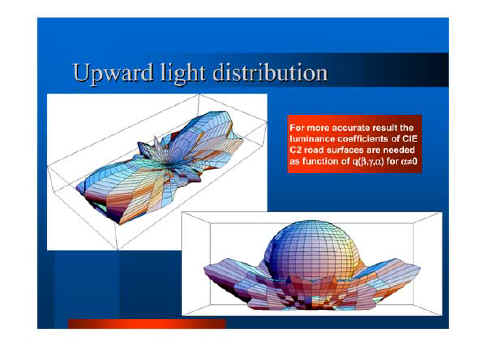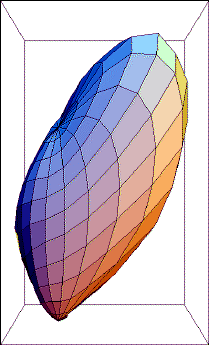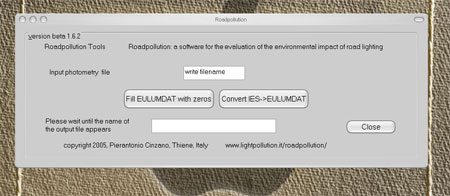
This is an unofficial feature. If you have Mathematica software and want try 3D plot of upward intensity of road lighting installations, download the file upflux.nb. You will have to replace 0 with 1 in the extend.txt file in order to allow writting of related output files. The 3d plot require (1) Mathematica software, (2) adding directory path and filenames in the Mathematica notebook and (3) sometime adjusting some plot parameters. Sometimes it does not come out well (e.g. if there are light baffles interpolation or too much road specular reflection comes bad). For this reason I reserved it for "power users". It comes out better with prismatic and lanterns than with nearly zero upward emission fixtures, obviously. Remember that 3D road reflection is only a rough model of lambertian plus specular reflexion fitted to the emission at 1 degrees elevation as given by CIE road tables.

Yes, but this application was poorly tested so you MUST check results by yourself. To rotate fixtures you need photometrical data up to gamma 180 degrees. Projector's photometry usually is given only up to 90 degrees. The Roadpollution Tools allow to fill of zeros the Eulumdat photometry in the range 90 to 180. It produces a .ldtf eulumdat file that you can use as input in Roadpollution. Obviously this operation can be done only for those fixtures which emission goes REALLY to zero UNDER 90 degrees, otherwise it will produce wrong results. Then you should set the proper tilt angle of the projector, an high density grid, a pole spacing sufficiently large that the contribution of adiacent projectors to illuminance is negligible and the correct pole height. The only results of the Report that can be used (remember that Roadpollution was written for road installations made from a sequence of luminaires and not for analyzing an individual fixture) are the upward intensities per unit flux of the projector, the upward fluxes of the projector, and, if the pole spacing is sufficiently large, the illuminance distribution produced by the projector on the ground surface. Average luminance, uniformity, utilization factors, photometric efficacy, road/out-of-road reflection parameters, etc. are usually not usable (unless you are lighting a road with projectors). Glare and luminance distributions refer to the position of a typical road observer so usually are also not usable (but GR provides a first guess of the situation).

The Roadpollution Tools should allow users to convert IES 1991 and IES LM-63-95 files (and may be also ANSI/IESNA LM-63-2001 files) of type C photometry in a pseudo-Eulumdat format which can be properly read from Roadpollution. "Pseudo" means that only the lines of the Eulumdat file required by Roadpollution are filled with proper data so they in general cannot be used with another software (If you need a full conversion IES to Eulumdat try e.g. Photometric Toolbox of Lighting Analysts, Inc). NOTE THAT the conversion was tested with few IES files because here in Europe only the Eulumdat format is used. Users from U.S. are expected to test it better.

Times ago I made a comparison between as number of professional lighting design softwares and I found non negligible differences between their results. In the majority of cases this is not due to errors in computations but to differences in adopted standard rules, grids, observers positions, interpolations and other convenctions. If you want compare Roadpollutions results with a lighting design software or two lighting design software between them, you should follow this checklist:
1) use the same grid. Standard rules usually use undersampled grids so a different number of grid points produces different results. In particular check if the first points of a row or a line are on the border of the grid or inside the grid. E.g. a grid with points on the border, just in front of the luminaire, could give slightly worse uniformity.
2) distinguish between quantities obtained for luminaires at left, at right or averaging/maximizing on both road lanes (like e.g. maintained luminance, uniformity, etc.) and compare only the same quantities.
3) use the same observer. Its position is different in some standard rules, moreover in some cases the observer moves with the observed point (moving observer), moves traversally to the road with the observed point or is fixed.
4) some quantities like the utilization factor are more accurate when calculated on an high resolution grid. Check if the software computes them on the same grid used to compute the luminance, like Roadpollution, or on a specific high-resolution grid.
5) do not mistake quantities "per unit lamp flux" with quantities "per unit luminaire flux".
6) differences in interpolation methods can also produce differences in results. Standard rules require at least quadratic interpolation but Roadpollution uses spline-interpolation that is belived to be in many cases more precise.
7) If you recognize non negligible differences between Roadpollution and your lighting design software, even after checking the list above, try to compare your software with other lighting design software from various manufacturers. If the differences with Roadpollution would be consistently larger than the average differences between lighting design softwares, you could send a message to the bug-report email address with (1) the used input photometry file, (2) the lighting designs obtained with your sample of softwares in .doc or .pdf format, the output files produced by Roadpollution for the same input parameters, the result of the checklist above and a list of the deviant quantities.
The answer is yes if the CD is free of charge, like those distributed at meetings, attached to magazines or to books. The distribution in CD for commercial purposes is unwelcome and requires specific permission request. In any case the credits, the disclaimer at the end of the user manual and the roadpollution web site www.lightpollution.it/roadpollution/ should be clearly readable by the user. The folders roadpollution.zip and rstools.zip cannot be modified in any way.
I prefer possibly that Roadpollution be downloaded only from the roadpollution web site. This assures that only the last version circulates in the web and pushes users to read recent FAQS, comments etc. Hence, please link www.lightpollution.it/roadpollution/ as download address.